How To Field Judge Mule Deer
Do you really care if you tin can tell the difference between a 190″ and a 215″ deer? Me neither. In those situations, I just shoot it! It is more useful when hunting public state to know how to gauge a two-three year old deer from a 4+ year onetime mature deer. This is usually the difference between a <145″ deer and a 160″+ deer. It's not that piece of cake to approximate this deviation when you lot are excited or don't have much background looking at mulie bucks. This article walks you lot through the organisation I have developed to quickly field judge mule deer bucks in these situations.
I use Boone and Crockett's scoring system as a framework. Scores don't mean everything simply they are incredibly useful for breaking things down to quick, useful metrics. We focus on easy to detect variables that are correlated to other positive antler characteristics. Those variables are first main beam mass, and so main beam spread (within spread), and so brow tines, and last fork symmetry.
Particularly in long-range situations, outset focus on the cadet's main beam. The main beam is the role of the antler that starts at the base and grows around towards the animals olfactory organ (F on the beneath B&C scoring moving-picture show). All other points are supported by the primary beam and it volition almost always exist reflective of the remainder of the rack. At long distances, likewise many folks go overwhelmed by the antler above the chief axle, peculiarly if they are apply to blacktail and whitetail. They strain to count points and guess the G2-G4 tines. Don't do that or y'all volition shoot young bucks. You volition crank your spotting telescopic to the max and that deer is going to somewhen expect big and mature.
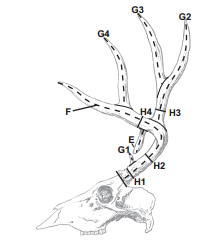
With your naked center, how far does the thickness in the base of the horns go out forth the main beam? On smaller bucks, from 200 yards away, yous will only be able to meet 5-10 inches of antler. Whatsoever mass that exists, dissipates quickly. It tin be hard to distinguish the main axle from the ears. On 160″+ deer you volition be able to make out the main beam all the manner until the end and it won't look similar it loses a ton of mass over the length. Deer with strongly visible beams are almost ever conveying a 4×four or meliorate rack, unless they are simply genetic derelicts. Next crank your optics downward on the animal and check the main beam spread ("Within Spread", D in the beneath B&C picture) relative to the animals ears.
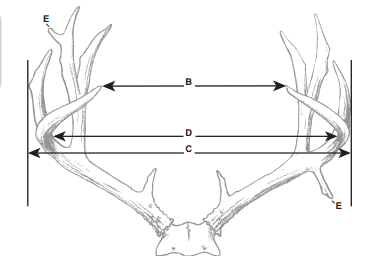
We want an beast that has an inside spread that is across the buck'due south ears. This equates to an inside spread of 19-23″. Heavy beamed deer with this width hardly always score below 160″ and they plow out to be peachy trophies. Even bucks with tall genetics volition be a niggling past their ears when they are mature. We are assuming the ears are in the normal position which is forrard and cocked slightly upwards. The offset deer photograph below is a good instance of this common position. Do non go fooled by deer that are running away. They typically hold their ears close together as they depart, giving the impression of wider antlers.
Let't take a look at a couple bucks:

This local deer is on the edge, merely he doesn't quite make the cut using our metrics so far. His inside spread is i-ii″ wider than his ears, just when you focus on this deer from a distance, the first thing you will notice is that he lacks mass. You will be able to make out his main axle just until it branches, 8-9″ from the base. His lack of a solid 4×4 rack and low overall mass is expected given his weak main beams. He probably scores effectually 135-145″ now, but will be a great deer in 1-2 years.
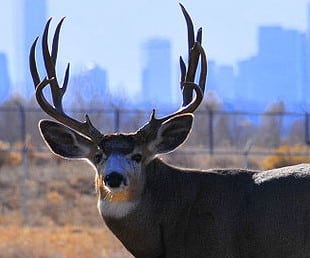
This deer, courtesy of Wikipedia, has a like inside spread, simply he has much heavier main beams. At 200 yards, you are going to be able to make out the curved main beam from base to finish with your naked heart. Ignoring the back 2 abnormal points, this deer is going to score around 185″+ and is clearly a mature mulie.
Before we move on, allow's talk well-nigh brow tines. The adept thing about brow tines (the commencement points coming out of the main beam) is they correlate to heavier main beams, which correlate to solid 4×4+ racks. In the pictures to a higher place, typical of younger deer the showtime deer does not have brow tines. The second, larger cadet has symmetric two-3″ brow tines. Keep in mind that there are mule deer areas where, genetically, it is common for no browtines or weak browtines, even for big mature deer.
At this point, y'all accept three metrics that you can solely apply to determine if a cadet is a mature, 160″+ deer, in 95% of cases. If a Colorado cadet has a xx″+ inside spread, heavy main beams, and symmetric brow tines he will almost certainly score 160″ or better. That's right, I don't fifty-fifty have to wait at his forks….just I'll practise it anyways to brand anybody happy.
Near mule deer scoring discussions start with the forks. It's important they are deep, aren't "crab claws", the back fork is tall, etc… The trouble is one of having no reference signal. I will illustrate by example.
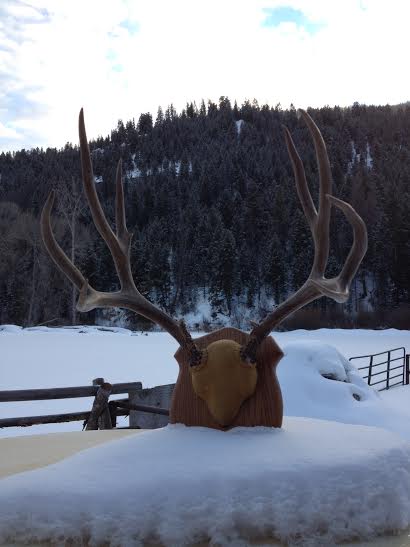
This buck has overnice, wide, well-developed and equal front-to-back forks. If you got on to this buck with a spotting scope and zoomed in on the meridian of his rack, it would exist piece of cake to call him a 165″+ plus deer. The reality is, although he is a really pretty deer, I scored him at only 149 i/8″. The missing piece when field judging based on forks is a known variable. If we added in a set of deer ears that we know are around 21″ wide and checked them confronting his primary beam, we would see that the inside spread of this deer is less than 17″. At present everything comes into perspective, including his forks.
The other trouble with focusing on forks is that forks will look brusque or even crab claw on heavier antlered bucks. Take a look at the cadet I'm holding beneath.

Information technology appears that this deer has similar length forks as the deer above. The measured reality is 70-fourscore% deeper forks. Fifty-fifty the back right fork is larger than any of the forks on the other cadet. The visual similarity is the illusion created past the deviation in mass betwixt the racks. I scored this buck as 179″. Hard to believe until you expect at the bucks together:
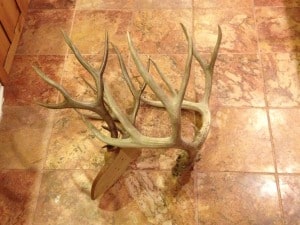
After all that negative chatter about using forks to field judge, I will say that asymmetric forks, front-to-back, is i of the best ways to disqualify deer from being shooters. Rarely a trophy class deer has crab claw front forks and dainty back forks. They have to have stunning mass for this not to exist the case. In the life span of bucks, they usually go through a couple youthful years of having one set of small-scale forks confronting a larger set. In our area, the back forks are much wider than front end forks on young bucks. It is an piece of cake way to classify deer in the <140″ range. Merely keep in listen I am talking nigh farthermost differences. The ameliorate forks volition await 3-4x wider/deeper than the poorer set.
Hope this helps you lot choice out a slammer on your next DIY, Drib Camp or Guided western mule deer hunt!
Source: https://www.flattopswildernessguides.com/what-makes-a-mature-mule-deer-basic-field-judging/

0 Response to "How To Field Judge Mule Deer"
Post a Comment